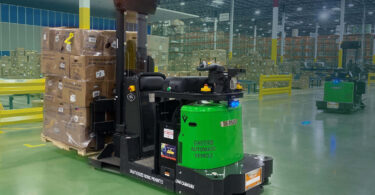Learn what's new with the updated ANSI B11.19 standard
The American National Standards Institute (ANSI) recently updated the ANSI B11.19 standard to provide more details on the application of risk reduction measures. As the main source for national standards to achieve the safety of people working with industrial equipment, the ANSI B11 Standards provide details on various aspects of machinery safety measures. The 2019 version is an effective complement to the risk assessment process by providing a near-complete list of risk reduction measures.
 Watch our webinar to get more information on the ANSI B11.19 standard.
Watch our webinar to get more information on the ANSI B11.19 standard.
With this recent update to the ANSI B11.19 standard, we’re here to help with any questions you may have. Here are some frequently asked questions regarding the standard answered by Chris Soranno, SICK Safety Standards and Competence Manager, and Dave Felinski, ANSI B11 Secretariat and President of B11 Standards, Inc.
Does ANSI B11 address safety integrity levels (SIL and/or PL)? How is the risk level evaluated and validated?
Soranno: A different standard in the ANSI B11 portfolio addresses functional safety performance. That standard, ANSI B11.26-2018, provides general principles for the design of safety control systems using ISO 13849-1. This standard also includes a clause addressing validation of the control system.
The ANSI B11.0-2020 standard addresses evaluation of inherent risk in order to determine performance commensurate with the identified risk, as well as validation of the overall risk reduction solution.
How “harmonized” are the various ISO/IEC standards with ANSI B11.19?
Soranno: Great care was taken by the B11.19 writing subcommittee to align as much as possible with the ISO/IEC standards referenced within ANSI B11.19. However, many of the international standards are quite old, and do not represent current technologies or best practices applied in industry today. In some cases, the alignment is 100% (for example, minimum gaps to avoid crushing). In other cases, the guidance provided in B11.19 may differ slightly in the results of an international counterpart – but the intent and basic philosophy are aligned. Therefore, it is hard to quantify and say ‘how much’ harmonization has been achieved.
As mentioned during the webinar, a few of those ISO standards are currently undergoing revision and it is noteworthy that those work groups are referencing ANSI B11.19 as current best practice during their revisions.

If B11 aligns with all these international standards, does it mean that if we design according to B11 we meet all the international standards as well?
Soranno: Alignment does not necessarily mean the results will be identical. At a philosophical level, both the B11 and international standards provide guidance that is believed to achieve an acceptable level of residual risk when correctly applied. However, there are slight differences that may result in different results. The foreword of ANSI B11.19 states:
The requirements of this standard have been harmonized with similar requirements in several international (ISO and IEC) and European (EN) standards. Harmonization means that the requirements have been aligned in essence to achieve a similar level of risk reduction. Harmonization does not mean duplication of exact requirements.
With the new ANSI standards, does this mean that the US will adapt to Performance Level ratings (ie: PLe) versus the SIL ratings (ie: SIL 3) to be achieved for safety devices/components, or are both ratings still applicable?
Soranno: Although neither of these standards have officially been adopted as an American National Standard, organizations and industries across the US are already applying the concepts of ISO 13849 (PL) and IEC 62061 (SIL). Safety device / component manufacturers who wish to continue servicing the global market will continue to apply either or both standards as appropriate for the technology.
Will the changes lead to the obsolescence to any current SICK safety devices?
Soranno: The majority of changes to ANSI B11.19 were actually additions (as well as reorganization of the content). As such, no safety devices from any supplier are known to have been affected.
Rather, the additions in the new revision address a broader variety of products and solutions which have already been deployed in industry, and provide guidance for the correct and appropriate application of such technologies.
What has been regulator response to integrating these standards into state or federal standards?
Felinski: That is a difficult and complicated question to try and answer; regulatory agencies are forced to engage in an extremely cumbersome and inefficient process to promulgate new rules or revise existing ones. They also tend to be more risk averse in adopting new approaches (even ones that are well-tried, tested and have a long history of successful use in industry). Our impression or viewpoint from our not infrequent dealings not only with federal OSHA but with state or regional counterparts as well is that generally speaking, the technical folks we talk to (inspectors, bureaucrats who write the regs, etc.) really do “get it” but their hands are all too often tied by the solicitor branches of their agencies and/or the inefficiencies of the regulatory rulemaking process itself. We suspect it is as frustrating for you as it is for us, particularly considering that at the end of the day, our penultimate goal is the same – to help people stay safe while working with machines (with an additional primary goal for us which is to provide requirements to the suppliers of those machines or equipment that facilitate that goal).
If I use ANSI B11.19 to design and test my machine in the US, can I use it as evident to meet European requirements without using ISO/IEC standards i.e. CE Marking?
Soranno: The EC conformity assessment procedure for machinery as outlined in the Machinery Directive provides various paths to achieve CE marking (see Annexes VIII, IX and X). Applying harmonized standards (as listed in the Official Journal of the European Union) is a common approach because it allows for the presumption of conformity to the essential health and safety requirements of the MD. However, other routes are available where application of a different standard – or a standard that addresses concepts not in an existing harmonized standard – can be used for a declaration of conformity.
Are annexes part of the standard?
Felinski: Yes, of course. They are as follows:
List of Annexes (all Informative)
- Annex A – Guidance to Understand the ANSI B11 Series of Stds & Tech.Reports
- Annex B – Hazard List for Risk Reduction Measures
- Annex C – Performance of the Safety Function(s)
- Annex D – Comparison of Physical Barriers
- Annex E – Reaching Distance Considerations for Protective Structures
- Annex F – Nip Guards
- Annex G – Considerations for Transparent Guards
- Annex H – Safety Distance Calculations for Engineering Controls – Devices
- Annex I – Reaching Distance Considerations for Engineering Controls – Devices
- Annex J – Measurement & calculation of system perf. to achieve a safe condition
- Annex K – Achieving a Safe Condition
- Annex L – Safety Functions for Power Drive Systems
- Annex M – Supplier Information for Time and Distance to Achieve a Safe Condition
- Annex N – Awareness Means
- Annex O – Risk Reduction Measures in Use
- Annex P – Cross-Reference Mapping of ANSI B11.19: 2010 vs. 2019
- Bibliography of Informatively Referenced International Documents
Is there any discussion of using the B11.19 standard in the review/changes possibly coming to 29 CFR 1910.147?
Felinski: Not that we are aware of though we are not privy to any of the internal agency deliberations/discussion taking place regarding dealing with the many comments submitted in response to their RFI last summer. Both the B11 Standards and ASSP filed formal comments with the agency urging them to consider the 2016 version of ANSI/ASSE Z244.1 AND to engage in meaningful outreach to the true ‘experts’ (namely those involved in the revisions of Z244.1 (2016), B11.0 (2020) and B11.19 (2019) which were many of the same individuals (and hence the very good alignment across those three standards).
![]() Want to learn more about the updated ANSI B11.19 standard? Read our white paper series to learn more: part 1, part 2, part 3.
Want to learn more about the updated ANSI B11.19 standard? Read our white paper series to learn more: part 1, part 2, part 3.




